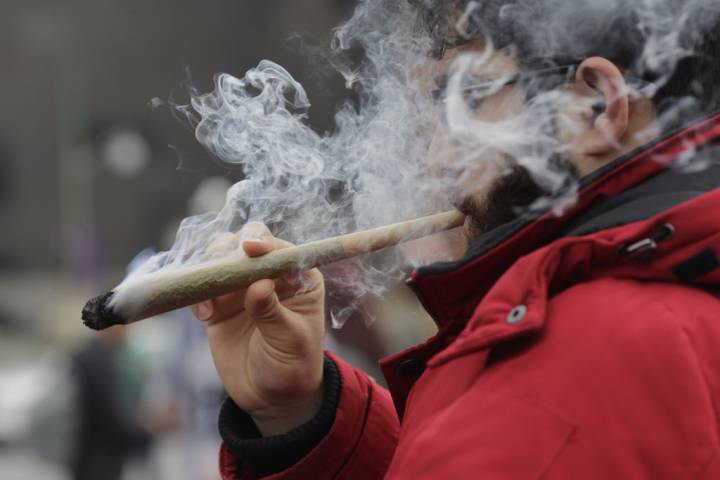Zach Walsh, Jenna Valleriani say it’s time for organizations to move away from half-truths and fear-mongering when discussing cannabis use
The New Brunswick Medical Society wants you to know that just because recreational cannabis will soon be legal in Canada, it isn’t necessarily “safe”.
Last month, the organization launched an educational campaign geared to youth and young adults about the risks associated with the use of recreational marijuana.
Unfortunately, two prominent Canadian researchers are calling it “a missed opportunity” to inform young people of the effects of cannabis, as the society’s key messages lack scientific backing.
“Marijuana is an inherently harmful substance, and we need to treat it as such if we are going to enable its recreational use through legislation and state-sponsored distribution,” reads an excerpt from a report by the society on LegalNotSafe.ca.
That sentiment is echoed in four central messages printed on posters as part of the society’s “It’s Your Choice” campaign.
“Regular marijuana use can cause depression, anxiety, and bipolar disorder in both adolescents and adults,” claims one of the posters.
Another says smoking marijuana “creates the same toxins and cancer-causing chemicals as smoking cigarettes,” while a third asserts that marijuana use under age 25 can “cause long-lasting damage to the brain.”
A fourth relays that a breastfeeding baby “can absorb up to eight times more THC than its mother.”
Taking a look at the campaign posters, Dr. Zach Walsh, psychology professor at UBC Okanagan, told the Straight in a telephone interview that the posters are problematic for a number of reasons.
“As a mental health professional, looking at that first claim about causing depression, anxiety and bipolar disorder, that’s an area I’m pretty familiar with,” he said. “I just don’t think that’s an accurate statement. I don’t know of any studies that have shown that.”
said that while some people may experience acute anxiety after using cannabis, there is not enough evidence to warrant the cross-sectional study required to bring truth to the society’s claim.
“There’s a number of factors for causation, a number of criteria we use in science, and we simply don’t have that when it comes to cannabis [and these mental health issues],” he said.
“What we’re seeing now is the result of years of exaggerated and frankly untrue propaganda campaigns, and rather than dissuade people from using cannabis, what they do is dissuade people from trusting authority.”
Walsh also observed that the claims are parsed in a way that absolves the society of being technically inaccurate, which he says, “makes me feel like they’re trying to deceive people”.
This is illustrated well in the poster that likens marijuana smoke to cigarette smoke.
“Smoking cannabis doesn’t have the same effects in terms of giving individuals cancer, in the way that cigarettes do—that we know—and because we know that, they’re not going to say it gives you cancer,” he said.
“It’s like saying, ‘We want to scare you, but unfortunately we’re bound by the truth’.”
Walsh added that a better name for the campaign might be, “Legal: Safer than illegal”.
Posters for the New Brunswick Medical Society’s “It’s Your Choice” campaign.
Jenna Valleriani, a PhD candidate in sociology at the University of Toronto whose research focuses on the legal and illegal cannabis markets in Canada, said she found the poster to be “more fear-based campaigning, dressed up as choice.”
Echoing Walsh, Valleriani said most of the claims found within the society’s messaging lack concrete evidence. She said the society is leaning on developing or incomplete research, “and transforming that into statements of fact.”
This can make things more confusing for parents, educators, and youth alike.
“The research around brain development and cannabis use outcomes has never established any causal link,” she said in reference to third poster.
Valleriani says she understands why medical professionals want to delay the onset of cannabis use among youth, but she takes issue with the suggestion that adults under 25 shouldn’t use cannabis.
“Some of the associations of this research are stronger when people use at a younger age, but most people are using it non problematically,” she said. “Setting up this story as the worst-case scenario is not good for youth who are just looking for information on using cannabis.”
Studies on the topic of breastfeeding and cannabis use are few and far between, but it’s easy to spot the miscommunicated information in the poster claiming that babies can absorb up to eight times more THC than their mothers.
In the latest version (2015) of Medication and Mother’s Milk, author Thomas W. Hale writes that in chronic cannabis users, the levels of active ingredients in breast milk couldbe eight times higher than the the amount in the mother’s blood. (That number based is based on a 1982 study in which one chronic cannabis user’s milk was tested against her own blood.)
As Walsh pointed out, the society’s rewording of this information appears to be intentionally deceiving.
“These are messages we’ve seen before, but we have an opportunity to do things differently,” said Walsh.
“We should do our best to really be honest when we’re looking out for the health of our citizens, instead of following this history of half-truths and sticking with stigma.”
Valleriani said that she hopes as more and more organizations consider creating guidelines around cannabis use, they include young people in the development of these programs.
“We’re so scared to talk about young people in a way that might acknowledge that they’re using cannabis,” she said. “We need education that actually resonates with youth… that serves both young people that don’t use cannabis, but also young people that do use cannabis.”
All in all, Valleriani said the New Brunswick Medical Society could have saved itself some money by simply replaying a certain ad from the ‘80s that alludes to a frying egg as the equivalent to “your brain on drugs”. She suspects that, as the generation before them did, young people will likely “make fun” of this campaign.
credit:420intel.com





